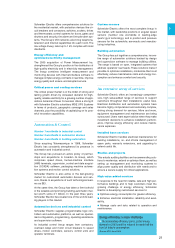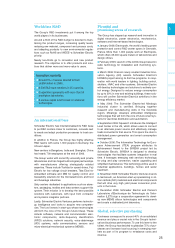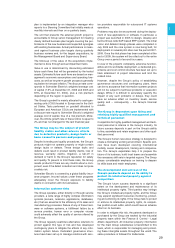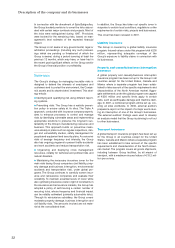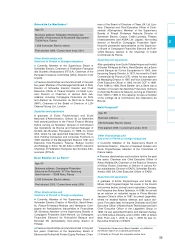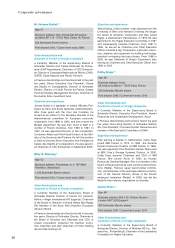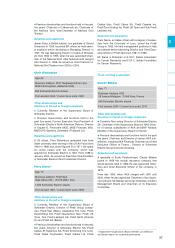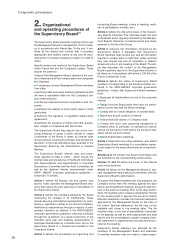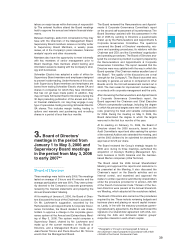APC 2006 Annual Report Download - page 33
Download and view the complete annual report
Please find page 33 of the 2006 APC annual report below. You can navigate through the pages in the report by either clicking on the pages listed below, or by using the keyword search tool below to find specific information within the annual report.
criteria, including the credit rating issued by an inde-
pendent rating agency.
Group policy consists of diversifying counterparty risks
and periodic controls are performed to check compli-
ance with the related rules.
Liquidity risk
Liquidity is provided by the Group’s cash and cash
equivalents and commercial paper programs. These
programs are backed by undrawn confirmed lines of
credit.
The Group’s credit rating enables it to raise significant
long-term financing and attract a diverse investor base.
The Group’s current credit rating is A, watch negative.
The Group’s liabilities and their terms and conditions
are described in note 17, pages 126 and 127 below.
Currency and interest rate risks are generally man-
aged at Group level, with the aim of limiting the impact
on results of changes in exchange and interest rates
without entering into any trading transactions. Hedging
decisions are made by the Finance & Control - Legal
Affairs department and are reviewed at regular inter-
vals based on changes in financial market conditions.
In line with the Group’s overall policy of conservatively
managing liquidity risk and protecting its financial posi-
tion, when negotiating new liquidity facilities the Group
resists the inclusion of clauses that would have the
effect of restricting the availability of credit lines, such
as covenants requiring compliance with certain finan-
cial ratios and material adverse change clauses.
The loan agreements for some of its liquidity facilities
nevertheless include cross-default clauses whereby if
the Group were to default on any of its liquidity facili-
ties, it would immediately be considered as having
defaulted on all such facilities. Moreover, anticipated
reimbursement provisions exist for certain financing
and lines of credit in case of change of control.
An increase in raw materials price could
have negative consequences
The Group is exposed to fluctuations in energy and
raw material prices (in particular steel, copper, alu-
minum, silver, nickel, zinc and plastic). If the Group is
not able to hedge, compensate or pass on its
increased costs to customers, this could have an
adverse impact on its financial results.
The Group has, however, implemented certain proce-
dures to limit its exposure to rising non-ferrous raw
material prices. The purchasing departments of the
operating units report their purchasing forecasts to the
Corporate Treasury Center. Purchase commitments
are hedged using forward contracts, swaps and, to a
lesser extent, options.
The financial instruments to hedge the exposure of the
Group to increase in raw materials price are described
in note 20.4 to the consolidated financial statements
for fiscal year 2006, page 129 below.
In 2006, purchases of raw materials totaled around
1 billion, including around 400 million for non-fer-
rous metals, of which more than 70% were for copper.
The Group enters into swap and options agreements
in order to hedge all or part of its raw material purchas-
es. Decisions to hedge such purchases, mostly of non-
ferrous metals, depend on Group forecasts of changes
of raw material market prices. As of December 31,
2006, Group hedges for non-ferrous metal purchases
amounted to 115 million, of which 80 million for
copper.
Equity risk
Exposure to equity risk primarily relates to treasury
stock and shares in AXA. These positions are not
hedged.
The Group’s products are subject
to varying national and international
standards and regulations
The Group’s products, which are sold in national mar-
kets worldwide, are subject to regulations in each of
those markets, as well as to various supranational reg-
ulations. Those regulations include trade restrictions,
tariffs, tax regimes and product safety standards.
Changes to any of these regulations or standards or
their applicability to the Group’s business could lead to
lower sales or increased operating costs, which would
result in lower profitability and earnings.
The products of the Group are also subject to multiple
quality and safety controls and regulations, and are
governed by both national and supranational stan-
dards, though the majority of the lineup complies with
world-recognized International Electrotechnical Com-
mission (IEC) standards. Costs of compliance with
new or more stringent standards and regulations could
affect its business if the Group is required to make cap-
ital expenditures or implement other measures.
Since the Group’s products comply with the dominant
standards in its host markets, the Group is able to
meet most all of its customers’ needs.
Claims, litigation and other risks
In 2001, Schneider Electric made a public offer to pur-
chase Legrand as part of a proposed merger project.
When the offer closed in July 2001, the Company held
98.1% of Legrand. In an initial decision dated October
10, 2001, the European Commission vetoed the merg-
er, and in a second decision dated January 30, 2002,
it ordered the two companies to separate as quickly as
possible. As a result, Schneider Electric sold its inter-
est in Legrand to the KKR-Wendel Investissement con-
sortium even though the Court of First Instance of the
European Communities overruled the Commission’s
decisions on October 22, 2002. Schneider Electric
launched proceedings against the European Commis-
sion to obtain damages for the prejudice caused, esti-
mated at 1.6 billion. Hearings are scheduled for 2007.
Following public offers launched in 1993 by SPEP (the
Group holding company at the time) for its Belgian
subsidiaries Cofibel and Cofimines, Belgium initiated
proceedings against former Schneider Electric execu-
tives in connection with the former Empain-Schneider
Group’s management of its Belgian subsidiaries. At the
end of March 2006, the Brussels criminal court (tribu-
nal correctionnel) ruled that some of the defendants
were responsible for certain of the alleged offenses.
The court also appointed an expert to assess the loss
suffered by those plaintiffs whose claims were ruled
admissible. The Group and its Belgian subsidiaries
Cofibel and Cofimines were held civilly liable for the
actions of their senior executives who were found
liable. The Group is paying the legal expenses not cov-
ered by insurance of the former executives involved.
31
1


